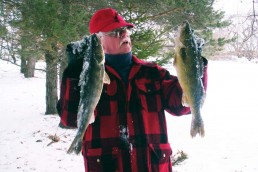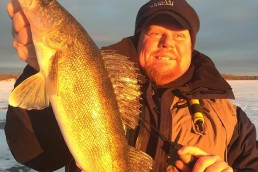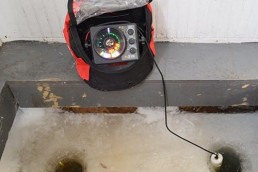Tactics for Icing Michigan Midwinter Walleyes
SHARE THIS POST
Getting things straight about dropping lines down ice holes and ice rigging to produce the best quality and quantity of walleyes in the time allotted is fun and satisfying. Testing new methods on dead-of-winter walleyes can be challenging, but if we can tip the scale favorably in our direction, we just might end up with a few delicious Michigan walleye fillets on the grill.
The pause, the nod and more
Big and little walleyes are not the same. Bigger walleyes—by nature of their experience and other factors—get larger by being wary and tentative, even when they want to eat.
One day in February at dusk on Little Bay de Noc near Escanaba, Mich., in the Upper Peninsula, a group of us “Yoopers” were marking walleyes not only with our Vexilars, but also with an underwater camera I brought along. Big female walleyes were below us, and coming in quick; they were stopping on a dime in front of our jig and minnow presentations. My buddy Joe Cuchane quickly switched to a small, fluttering spoon. Joe decided to work the bottom by lifting up and dropping it down. Then he switched to a PK Spoon, which has a teardrop design that not only allows it to flash and vibrate, but also lay on its side the first half of the fall. Yes, it shimmies and shakes vertically on the fall, looking like a wounded, edible “something.” Then, the heavier butt section of the spoon works its magic and settles like a rock. But then it makes a little swing back into position from where it first settled, like an enticing flutter spoon that drives walleyes crazy.
The PK Flutterfish is a slender, peanut-shaped spoon that works better—for the most part—above the bottom and has different characteristics and brings in walleyes. Then it’s up to the angler to read the mood and make the moves for a hook-set.
Walleyes make us better anglers. I know the significance of the “pause” while playing a fish and also working the bottom for this species, but now let’s discuss another move—the “nod.”
Jeff Simpson is the In-Fisherman digital editor, a veteran of walleye fishing and is well versed in the “nod.”
“A nod should start just after a fish has moved in and won’t respond,” says Simpson. “Sometimes all it takes is the slightest movement beyond the barest movement already inherent in the pause. Nodding doesn’t require conspicuous movement of your hand or wrist—just squeeze the rod handle with the palm of your hand and fingers. If it’s obvious, it isn’t a nod, it is a jiggle or a shake, which are more aggressive moves reserved for swimming lures like the Jigging Rap, or working spoons for active walleyes typically during prime-time low-light periods.”
Nodding can also work when using a plain hook or a hook and a minnow head. Here, just move the minnow head so it barely dances. Most ice anglers can watch a reaction on their locator as they move a lure up and down, even banging the bottom. Here you can move a lure up—and you can pause. No takers; try the nod. It should seal the deal.
Jig styles: old and new
While in Minnesota last year I learned a few things about walleye fishing while I was at Lake of the Woods. While fishing and visiting various sport shops, I learned a few things advantageous to walleye fishing in Michigan or anywhere, especially in rivers. (The photos with this are jigs we used, successfully I might add.) The principles of attract-and-trigger with flash and vibration once again can be seen by the jigs and willow blade designs, especially the clacker-type jigs that got lots of attention.
There is also the stand-up design with stinger hooks attached, and ball jigs that work well in current (i.e. Rainy River)—talk about flapping and clacking attraction (see photos).
Popsicle minnows
If that wasn’t enough, here’s something I’ve never heard before: Sticking several frozen minnows on a jig—a couple of 3- to 4-inchers per jig—produces a scent five times stronger than lively minnows, according to local bait shops. This method seems to work better than live bait in stained water, especially in a current. It’s smelly and effective.
In an area where ice fishing is a religion, locals and visitors alike catch lots of walleyes by loading up their jigs with these “popsicle” minnows, especially on a stinger-hook jig.
Drop-shotting: old and new
Another old tactic I overheard while hanging around Luckey’s Sport Shop in Iron River, Mich., is a presentation involving rigging for walleyes with the “old reliable,” but simple drop-shot rig. One of the advantages discussed was the fact that this method eliminated line twist, which produces a spinning jig.
Are you enjoying this post?
You can be among the first to get the latest info on where to go, what to use and how to use it!
Active first-ice fish don’t care if a jig is spinning, but midwinter ‘eyes do. So, use a drop-shot rig with the sinker resting on the bottom below the hook. The fish do not feel the weight and sometimes ‘eyes will take a resting bait on the bottom. No movement at all can be a trigger.
A good idea is to tie a swivel on the main line and then use the top swivel eyelet for tying an 8- to 12-inch leader line with a #1 or 1/0 short shank, walleye hook. Then use the bottom swivel and tie a mono line with a bell sinker on it. Be sure that you hook a live minnow in front of the dorsal fin. But that’s not all. Hook the minnow parallel to the backbone with the hook pointing at the head—it makes for a better hook-set.
The idea is to present a lively minnow swimming around in a circular arc until the minnow tires and rests. Then, after this pause, jig the pole and start the minnow “polka dance” again.
Is it OK to let the minnow ret on the bottom? You bet. Is it OK to use a deadstick presentation by placing the pole on the top of a bucket, letting it rest? Why not? Every minute or so, tap the pole with your finger and you have a dancing minnow again.
Finally, you can let out up to 10 feet of line by opening the bale and letting the minnow do its thing, fluttering in place, then struggling and moving around in circles. I use this rig and sometimes it’s the only pole I use. It’s that good.
Innovations and the double-dropper
Another innovation to fool sluggish walleyes that’s fun is to put spaced, small split-sinkers on 4-pound-test and create a scenario where the minnow swims and falls back from its arc in a struggling fashion because of the weight of the split-shot. Midwinter walleyes hit this lively, struggling minnow set-up.
Then there is a favorite rig of mine: Using spoons instead of sinkers allows me to bang a heavy spoon on the bottom, calling fish to swim in and see what the commotion is all about. They watch sediment puffing up from the bottom; all this attraction occurs as a minnow is attached up above the main line to a small leader attached with a Palomar knot. Or, you can use a nifty, little clear plastic Bear Paw line connector made by Bear Paw Tackle Company out of Bellaire, Mich.
Hey, you can jig the spoon too. I like to use a rattling spoon with a 4-inch dropper line connected to a jig or plain hook to a dropper line—a double-dropper, if you will. You can twitch this lure and create chaos and turmoil.
This led to other innovations.
Walleyes can see well in low-light conditions. We all know that, but sometimes we forget they can taste and smell very well. Scent brings all fish in to investigate. So why not add a minnow head? Instead of cutting the minnow head clean off, try the fine art of “squishing” the minnow head. Pinch it off, leaving some ragged meat hanging, then squish it a tad to add more scent.
These tips and tactics should make sense to all of you who have ever dropped a bait down an ice hole.
Because I’m a bona fide “fish brain” with an aquarium inside my cranium, I see succulent walleyes swimming around in 4/4 time—just beneath the ice in your favorite spot, so set the hook.
MWO
SHARE THIS POST
Did you enjoy this post?
You can be among the first to get the latest info on where to go, what to use and how to use it!
Robert Dock Stupp
MidWest Outdoors works with more than 200 outdoor experts each year, who contribute articles based on their areas of expertise. MidWest Outdoors magazine offers more fishing and hunting articles than any other publication!



